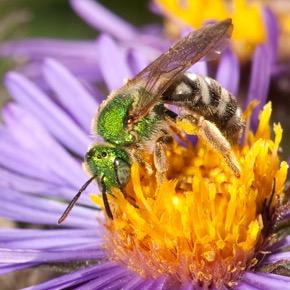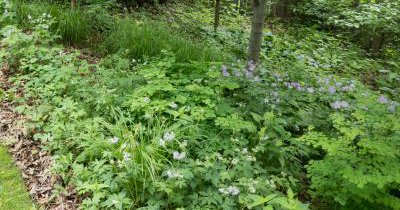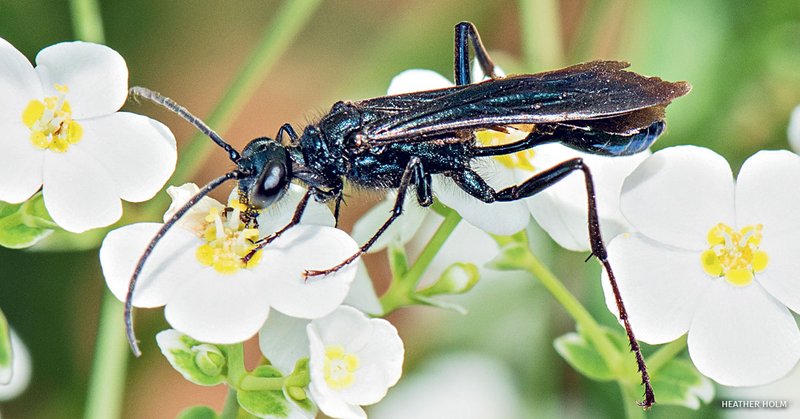
Heather Holm
@BeesNativePlant
Followers
3K
Following
1K
Media
314
Statuses
641
Heather Holm - author of Pollinators of Native Plants, Bees, and Wasps. Pollinator Conservationist and Environmental Educator
Minnesota
Joined May 2015
My latest storymap features Soft Landings, a concept developed by Leslie Pilgrim and me. This concept builds upon @DLNarango's research on leps and host plants. Soft Landings are diverse native plantings under the dripline of keystone native trees. Link:
2
10
25
RT @Dmizejewski: Fantastic storymap by @BeesNativePlant on creating "soft landings" of native vegetation & leaf layer under keystone trees….
storymaps.arcgis.com
Diverse Native Plantings Under Keystone Trees
0
4
0
RT @McmackinRebecca: @CatrinEinhorn And so happy to be alongside rockstars @BeesNativePlant and @SaveWildBees Go team bees!.
0
2
0
Yesterday, cellophane #bee (Colletes inaequalis) females perched at their nest entrances in morning, waiting for temps to warm up. Males patrolling nest aggregation. In afternoon, females visited pussy willow. Nest provisioning iminent after today's rainy weather subsides.
2
9
35
RT @CWF_FCF: Join CWF April 11th as Heather Holm, highly-respected researcher and award-winning author, shares her discoveries and beautifu….
0
8
0
"It turns out I’ve been filling my yard with a mix of ecological junk food and horticultural terrorists." 😆.
washingtonpost.com
Your lawn and garden are helping to doom the Earth. If you want to save the planet, all you really need to do is plant a single oak tree.
0
19
46
My latest storymap titled Signs of Spring, features the unequal cellophane bee (Colletes inaequalis). Learn more about the natural history of this early spring solitary bee and the native plants it depends on:.#bees #pollinators #nativeplants
2
22
73
Latest video on my YouTube channel features the unequal cellophane bee (Colletes inaequalis). This bee species is active in early spring—as early as the end of March in MN. Watch the video to learn more about this bee's natural history: .#bees #pollinators.
0
6
20
Wasp photos taken Thursday including another observation of Zethus spinipes, a recent arrival to MN. Photo 1) Zethus spinipes spinipes.Photo 2) Parancistrocerus leionotus.Photo 3) Episyron biguttatus.Photo 4) Ancistrocerus adiabatus.#WaspLove #nativeplants #beneficialinsects
1
3
34
RT @EvolvingWild: We got Pollinators of Native Plants by @BeesNativePlant in the mail today and it is such an amazing book. Just so much in….
0
5
0
RT @WaspWoman: Loving the positive press #wasps are getting this summer!! @BeesNativePlant Thanks @NWF @InsectFan! Reconsidering Wasps http….
nwf.org
The much-maligned insects provide vital ecosystem services
0
13
0
My friend Angela Grill emailed me about some bicolored striped striped sweat bees (Agapostemon virescens) nesting in the lawn at her workplace. A communal nest with four separate tumuli. Photos of nest guard and female departing. #bees #pollinators #nativebees #nests
0
3
24
The large black cherry that fell in our yard had several types of wasps nesting in the dry, rotting core including an Ectemnius (possibly E. cephalotes), Crossocerus annulipes, and a Pemphredon (not shown). See photos of prey (flies and leafhoppers). #wasplove #wasps #crabronid
0
3
15
The second wasp I observed collecting clumps of clay in the garden to partition/seal her nest - Trypoxylon sp. Trypoxylon generally nest in preexisting cavities although the organ pipe mud dauber (Trypoxylon politum) constructs free-form mud nests that resemble organ pipes. #wasp
0
1
2
An Auplopus female gathers a clump of damp sand. Spider wasps in this genus construct mud nests, usuallly attached to an object. I am still looking for this wasp's nest — it may be underneath a rock. Stay tuned. #spiderwasps #beneficialinsects #wasplove
0
5
38




























